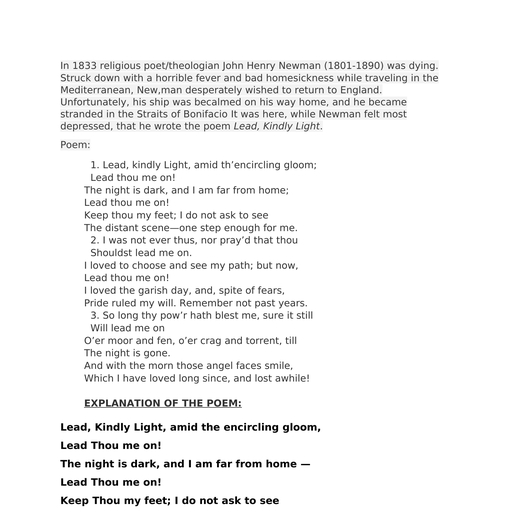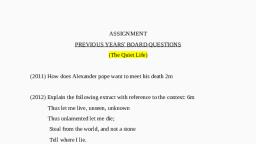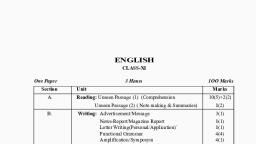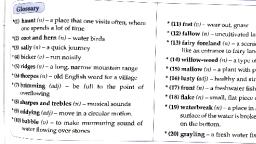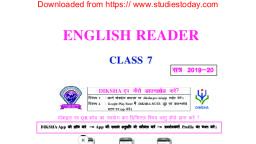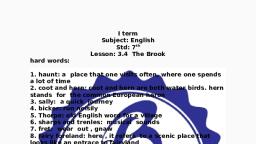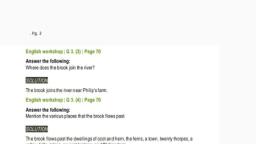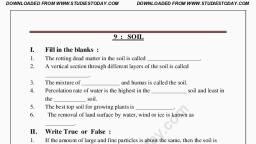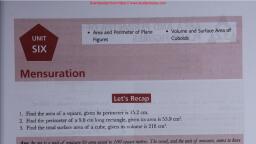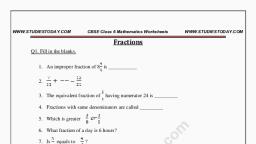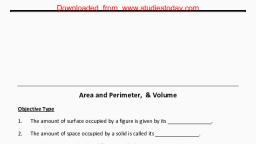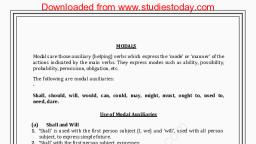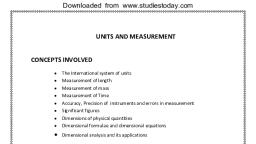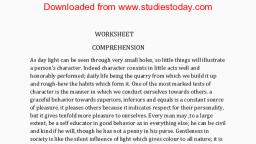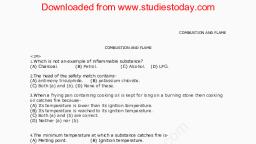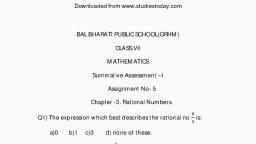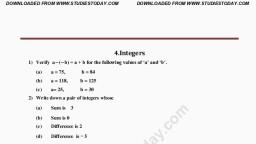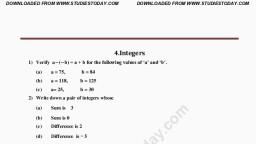Page 1 :
Downloaded from www.studiestoday.com, , 6, , Poetry, P. 1, , UNIT, UNIT, , The Brook, by Alfred Lord Ten n yson, , 1., , 2., , Can you match the following?, (a) Something that lives for one year, , biennial, , (b) Something that lives for about two years, , perennial, , (c), , annual, , Something that lives for more than two years, , Here is a list of a few things. Can you tell how long each of them can live /exist?, (a) a dog, (b) an elephant, (c), , a tree, , (d) a human being, (e) a star, (f), , a mountain, , (g) a river, 3., , The poem is about a brook. A dictionary would define a brook as a stream or a, small river. Read the poem silently first. After the first reading, the teacher will, make you listen to a recording of the poem. What do you think the poem is all, about?, I come from haunts of coot and hern;, I make a sudden sally, And sparkle out among the fern,, To bicker down a valley., , haunts: places frequently visited by, coot: a type of water bird with a white spot on the forehead, hern: heron, (another kind of water bird), sally: emerge suddenly, bicker: (here) flow down with a lot of noise, , Downloaded from www.studiestoday.com, , CBSE, , 57
Page 2 :
Poetry, , Downloaded from www.studiestoday.com, 5, , By thirty hills I hurry down,, Or slip between the ridges,, By twenty thorpes, a little town,, And half a hundred bridges., Till last by Philip's farm I flow, , 10, , To join the brimming river,, For men may come and men may go,, But I go on for ever., I chatter over stony ways,, In little sharps and trebles,, , 15, , I bubble into eddying bays,, I babble on the pebbles., With many a curve my banks I fret, By many a field and fallow,, And many a fairy foreland set, , 20, , With willow-weed and mallow., I chatter, chatter, as I flow, To join the brimming river,, For men may come and men may go,, But I go on for ever., , 25, , I wind about, and in and out,, With here a blossom sailing,, And here and there a lusty trout,, And here and there a grayling,, And here and there a foamy flake, , 30, , Upon me, as I travel, With many a silvery waterbreak, Above the golden gravel,, , CBSE, , 58, , thorpes: a village, trebles: high pitched tune, eddying: spiral movement of water, babble: sound made when one talks gaily, fallow: land left uncultivated to regain fertility, foreland: piece of land that extends into the sea, mallow: plant with hairy stems and leaves and pink, white or purple flowers, lusty trout: a big freshwater fish, grayling: another type of fish, , Downloaded from www.studiestoday.com
Page 3 :
And draw them all along, and flow, To join the brimming river, 35, , For men may come and men may go,, But I go on for ever., , Poetry, , Downloaded from www.studiestoday.com, , I steal by lawns and grassy plots,, I slide by hazel covers, I move the sweet forget-me-nots, 40, , That grow for happy lovers., I slip, I slide, I gloom, I glance,, Among my skimming swallows;, I make the netted sunbeam dance, Against my sandy shallows., , 45, , I murmur under moon and stars, In brambly wildernesses;, I linger by my shingly bars;, I loiter round my cresses;, And out again I curve and flow, , 50, , To join the brimming river,, For men may come and men may go,, But I go on for ever., About the Poet, Lord Tennyson (1809-92) was born in Lincolnshire. Poet Laureate for over 40 years,, Tennyson is representative of the Victorian age. His skilled craftsmanship and noble, ideals retained a large audience for poetry in an age when the novel was engrossing, more and more readers. Tennyson's real contribution lies in his shorter poems like, The Lady of Shallot, The Princess, Ulysses, The Palace of Art etc. His fame, rests on his perfect control of sound, the synthesis of sound and meaning, the union, of pictorial and musical., , 4., , After reading the poem answer the following questions., The poet has used a number of words which indicate 'movement' and 'sound'. Working, with your partner make a list of these words from the poem and complete the web chart., , hazel: a small tree or bush with edible nuts, forget-me-nots : a type of flower, shingly: covered with small rounded pebbles, cresses: pungent leaved plant like a cabbage, , Downloaded from www.studiestoday.com, , CBSE, , 59
Page 4 :
Poetry, , Downloaded from www.studiestoday.com, a., , sally, sparkle, , Movement words, , b., 1. bicker, , 5., , 2., , Sound Words, , 3., 4., , c., , CBSE, , A word or a combination of words, whose sound seems to resemble the sound it, denotes (for example: "hiss", "buzz", "etc.) is called onomatopoeia. From the words that, you have filled in the blurbs above point out these words., , 1., , 2. Pass through, valleys and, towns, , 3., , 6., , 5., , 4., , 7. Joins the river, , 60, , Downloaded from www.studiestoday.com
Page 5 :
5., , The following is a flow chart showing the course of the brook. Can you fill in the, blank spaces with help from the phrases given below?, a) passes under fifty bridges; b) comes from the place where coots and herons live;, c) passes lawns filled with flowers; d) crosses both fertile and fallow land; e) goes, through wilderness full of thorny bushes, , 6., , Poetry, , Downloaded from www.studiestoday.com, , On the basis of your understanding of the poem, answer the following questions, by ticking the correct choice., , (a) The message of the poem is that the life of a brook is ___________., (i), , temporary, , (ii), , short-lived, , (iii) eternal, (v), , momentary, , (b) The poet draws a parallelism between the journey of the brook with ___________., (i), , the life of a man, , (ii), , the death of man, , (iii) the difficulties in a man's life, (iv) the endless talking of human beings, (c), , The poem is narrated in the first person by the brook. This figure of speech is ________., (i), , Personification, , (ii), , Metaphor, , (iii) Simile, (iv) Transferred epithet, (d) In the poem, below mentioned lines :, "And here and there a lusty trout ,, And here and there a grayling", suggest that _____________., (i), , the brook is a source of life., , (ii), , people enjoy the brook., CBSE, , (iii) fishes survive because of water., 61, , Downloaded from www.studiestoday.com
Page 6 :
Poetry, , Downloaded from www.studiestoday.com, (iv) the brook witnesses all kinds of scenes., 7., , Answer the following questions., (a) How does the brook 'sparkle' ?, (b) 'Bicker' means 'to quarrel'. Why does the poet use this word here?, (c), , How many hills and bridges does the brook pass during its journey?, , (d) Where does it finally meet the river?, (e) Why has the word 'chatter' been repeated in the poem?, (f), , 'With many a curve my banks I fret'. What does the poet mean by this statement?, , (g) 'I wind about, and in and out'. What kind of a picture does this line create in your, mind?, (h) Name the different things that can be found floating in the brook., , 8., , (i), , What does the poet want to convey by using the words 'steal' and 'slide'?, , (j), , The poem has many examples of alliteration. List any five examples., , (k), , 'I make the netted sunbeam dance'. What does 'the netted sunbeam' mean? How, does it dance?, , (l), , What is the 'refrain' in the poem? What effect does it create?, , Read the given lines and answer the questions, I chatter, chatter, as I flow, To join the brimming river,, For men may come and men may go,, But I go on for ever., a), , Who does 'I' refer to in the given lines?, , b), , How does it 'chatter'?, , c), d), 9., , Why has the poet used the word 'brimming'? What kind of a picture does it create?, Explain the last two lines of the stanza., , Identify the rhyme scheme of the poem., , 10. The poem is full of images that come alive through skilful use of words. List out, any two images that appeal to you the most, quoting the lines from the poem., CBSE, , 11. The brook appears to be a symbol for life. Pick out examples of parallelism, between life and the brook., , 62, , Downloaded from www.studiestoday.com
Page 7 :
12. This poem describes the journey of a stream from its place of origin to the river, that it joins. The poem has been written in the form of an autobiography where, the brook relates its experiences as it flows towards the river. In Literature such a, device by which an inanimate object is made to appear as a living creature is, called Personification. Just as the brook has been personified in this poem, write, a poem on any inanimate object making it come alive. You could begin with a, poem of 6-8 lines. The poem should have a message. Maintain a rhyme scheme., Try and include similes, metaphors, alliteration etc. to enhance the beauty of the, poem. You could write a poem on objects such as the candle/a tree/a rock/the, desert etc., , Poetry, , Downloaded from www.studiestoday.com, , This could be given as a homework activity. The teacher could read out some of, the poems in the class and display the others., , CBSE, , 63, , Downloaded from www.studiestoday.com
